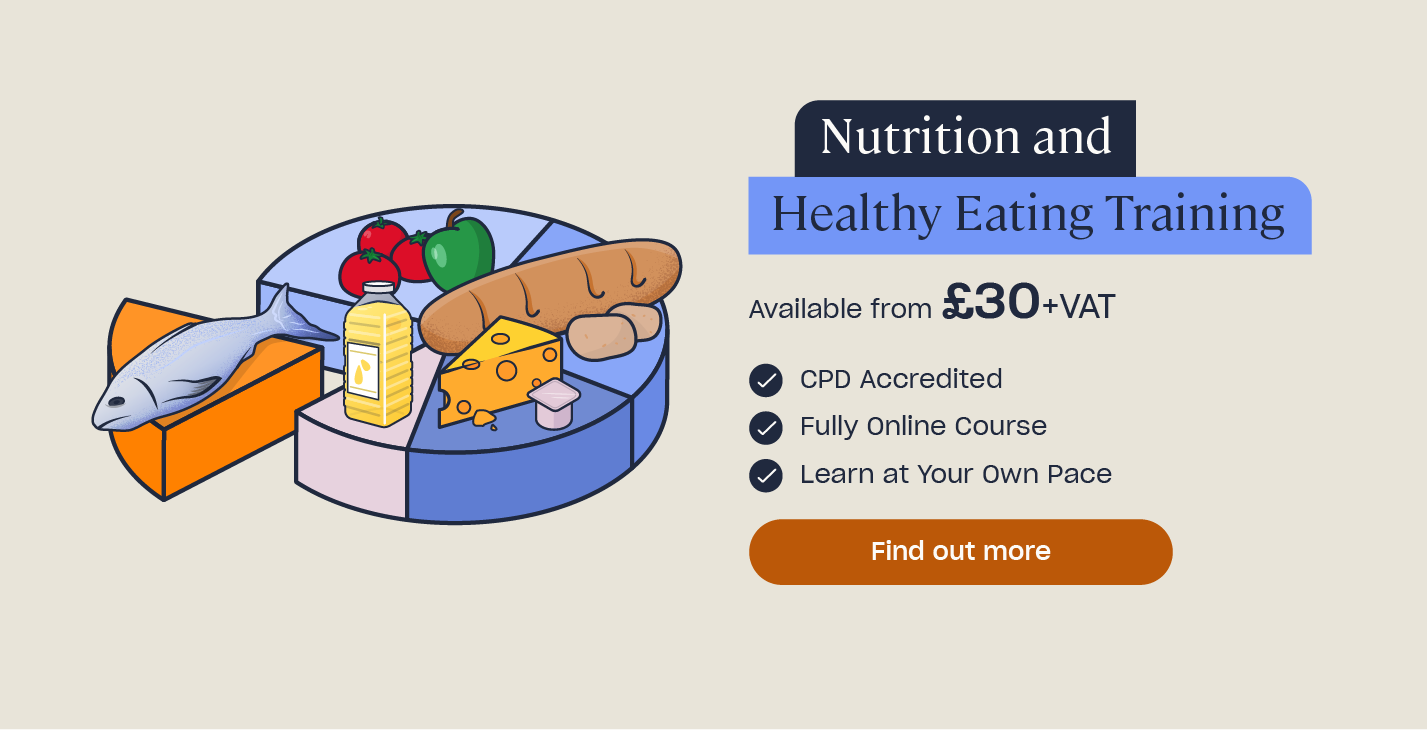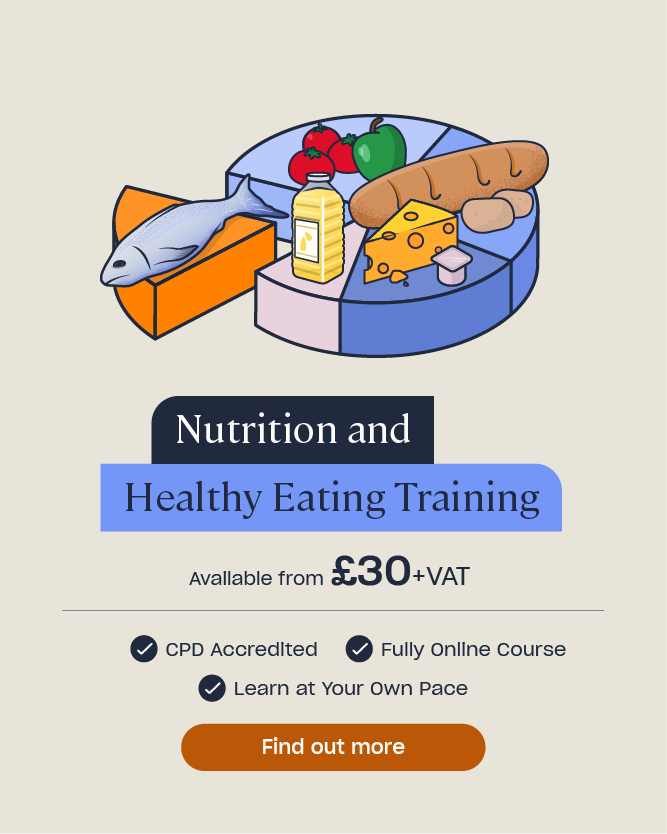A Vegetarian Diet: What Can I Eat & What are the Benefits?
Making the transition to a vegetarian lifestyle can at first seem like a daunting leap to make. You may assume that a diet without meat or fish is going to be restrictive, hard to cater for and lacking essential nutrients. But this certainly doesn’t have to be the case. Most people find that a vegetarian diet gives them an opportunity to discover new foods. Often, they feel healthier and happier having made the switch.
You may choose to go vegetarian for a number of different reasons. For example, animal welfare, religion, health, environmental concerns or to reduce expenses. Regardless of why, it is clearly becoming an increasingly popular diet. According to statistics published by the Vegan Society, it’s predicted that vegetarians and vegans will make up a quarter of the British population in 2025.
Like any diet change, it can be daunting to know where to start and what you can actually eat if you don’t have the right information. Whether you’re vegetarian already or wanting to know more about the diet, our guide will explain the numerous benefits of a vegetarian diet and what you can eat, including some recipe inspiration.
What Can Vegetarians Eat?
A fully vegetarian diet is that which excludes fish, meat and poultry. Vegetarians don’t eat products or by-products of the slaughter of animals, such as foods which have been made using processing aids from slaughter. You may also come across the following terms:
- A lacto-ovo vegetarian, or just a vegetarian, is the main type. It excludes fish, meat and poultry but includes dairy and egg products.
- A lacto vegetarian diet excludes eggs, as well as fish, meat and poultry.
- An ovo vegetarian excludes dairy, as well as fish, meat and poultry from their diet.
- Pescatarians eat fish, egg and dairy products, but exclude meat and poultry from their diet.
- A flexitarian diet is largely vegetarian but occasionally includes fish, meat and poultry. People often adopt this diet in an attempt to reduce their carbon footprint and improve their health.
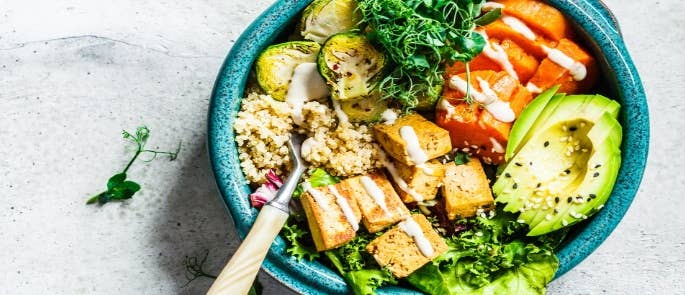
What’s the Difference Between a Vegetarian and a Vegan Diet?
A vegan (or plant-based) diet is different to a vegetarian one in that it excludes all animal by-products, such as dairy, eggs and honey, as well as fish, meat and poultry.
Veganism is more than just a diet, however. It’s a lifestyle choice whereby vegans avoid contributing to all forms of animal exploitation in their lives. This includes excluding animal-derived materials like wool and leather, products that are tested on animals, such as beauty products, and avoiding places that use animals for the entertainment of humans, such as circuses.
If you want to learn more about a vegan diet and what foods to eat to ensure you get enough vitamins and minerals, take a look at our article ‘A Vegan Grocery List – 50 Ideas for a Healthy Vegan Kitchen’.
How to Achieve a Balanced Vegetarian Diet
Like any diet, you need to ensure you eat the right foods from each food group to achieve a healthy, balanced diet. The UK government’s Eatwell Guide shows how much of what you eat overall should come from each of the five food groups: fruits and vegetables, starchy carbohydrates, protein, dairy and dairy alternatives (calcium) and oils and spreads (fats).
To achieve this balance as a vegetarian, the Eatwell Guide recommends that you ensure your diet is made up of approximately:
- 40% fruit and vegetables. You should aim to eat at least five portions of fruit and vegetables every day. Each portion should be roughly 80 g and can be fresh, frozen, tinned, dried or juiced. Eating this amount will provide you with the vitamins, minerals, fibres and calcium that everyone needs.
- 38% starchy carbohydrates. For example, pasta, rice, bread, potatoes and cereals. Aim for wholegrains where possible. This will provide you with the starch, fibre, calcium, iron and B vitamins that you need.
- 12% protein. Examples of vegetarian sources of protein include pulses and legumes (lentils, chickpeas, beans), eggs, nuts, seeds, tofu, tempeh and other meat-free sources such as mycoprotein (Quorn products). In addition, these sources all contain fibre, vitamins, minerals and iron.
- 8% dairy or dairy alternatives. Milk, cheese and yoghurt are all good sources of calcium, protein and some vitamins A and B12. Various dairy-free alternatives also often contain calcium, vitamin D and vitamin B12.
- 1% oils and spreads. This includes oils such as vegetable, sunflower and olive, as well as spreads containing these unsaturated fats. It also includes foods high in saturated fats, sugar and salt such as chocolate, cake, butter and crisps.
The percentage of each food group is the same whether your diet is vegetarian or not, and you should use this guide to determine what food you eat.
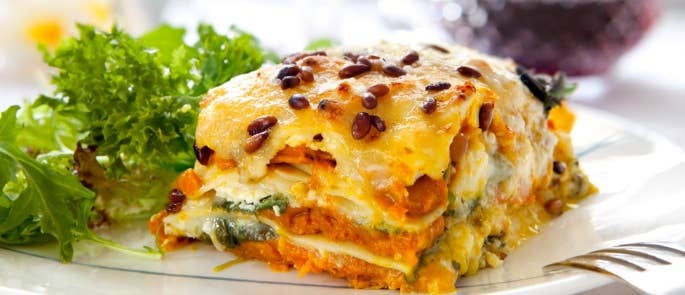
What are the Benefits of a Meat-Free Diet?
A vegetarian diet comes with a whole range of benefits. Followed correctly, it will have a significant positive impact on your health, the environment and animal welfare. In addition, following a vegetarian diet can also help you to spend less and save more money. Meat and fish are often expensive, especially in comparison to their vegetarian alternatives of vegetables, pulses and beans.
You may also want to consider what you are actually putting into your body. Did you know that red meat can be full of toxins such as polycyclic aromatic hydrocarbons (PAHs) that may cause cancer, while some fish contain mercury, another known toxin? It’s also worth noting that processed meat is classed as a group 1 carcinogenic by the World Health Organisation. This is the same category as cigarettes, alcohol and asbestos. Similarly, red meat is classified as a group 2A carcinogen. If you want to avoid putting these into your body, you may want to reconsider your diet.
If you think you’ll struggle to go fully vegetarian at once, there are other ways to start making a conscious effort to cut down on the animal products you eat. You could try to adopt a ‘meat-free Monday’, a campaign launched by Paul, Stella and Mary McCartney in 2009. The idea behind this is to raise awareness of the devastating impact animal agriculture and industrial fishing has on the environment, and demonstrate how eating vegetarian food only for just one day a week comes with benefits.
If every household in the UK was to eliminate meat from just one meal a week, it would have the same environmental impact as removing 16 million cars from the roads. This represents a reduction of up to 8.4% of the UK’s total greenhouse gas emissions.
Health Benefits
You’ve already seen how a vegetarian diet lends itself to fulfilling the recommended proportions of different food groups by the EatWell Guide. A vegetarian diet is naturally high in fibre, vitamins and nutrients and low in saturated fat, particularly in comparison to a non-vegetarian diet. It is proven to reduce the risk of health complications such as heart disease, some types of cancer and Type 2 diabetes. It is also linked to a lower BMI and weight loss.
A concern that some people have about vegetarianism is that it lacks the nutrients found in fish, meat and poultry. However, you can find all these in a vegetarian diet. Indeed, the majority of animals get their protein from plants and so by eating a vegetarian diet you directly get the nutrients you need.
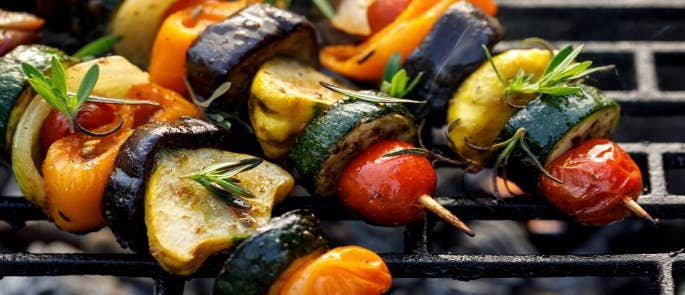
As with any diet though, you need to be eating the right foods in the right amounts to ensure you get this health balance. While a diet of pizza, chips and chocolate may still be suitable for vegetarians, it won’t provide you with the foods you need and so you likely won’t see any health benefits — you may, in fact, feel worse.
It is important that you make sure you are still getting the balance in your diet right. Meat is a source of protein and so you need to replace this with alternatives. For example, lentils, chickpeas, eggs, cheese, tofu, tempeh and other meat-free sources such as mycoprotein (Quorn products) all contain protein. You can also get it from green leafy vegetables like spinach and broccoli, so you have plenty of options to ensure you get the nutrients needed.
Environmental Benefits
Countless scientific studies have found that a meat-free diet has environmental benefits. A 2018 study by Oxford University found that ‘avoiding meat and dairy is the single biggest way to reduce your impact on Earth’. Eating a vegetarian diet will minimise your carbon footprint and reduce your impact on climate change. This is because a vegetarian diet requires 2.5 times less carbon emissions than a meat diet.
Livestock need massive amounts of land, water, feed and other resources before they end up in the supermarket, a process that totals 30% of all global greenhouse gas emissions. 70% of the world’s soy is fed to livestock, while only 6% actually becomes food for humans. Arguably, these resources could much better be used for humans who are suffering from hunger or food insecurity. The need to breed an unsustainable number of animals for human demand could be avoided if people adopted a vegetarian or vegan diet.
The environmental benefits of adopting a vegetarian diet are vast. In addition to the reasons explained above, it can also reduce:
- The amount of methane and nitrous oxide produced by cattle. Like carbon dioxide, these gases contribute to global warming. If these animals aren’t bred at the rate at which they currently are to meet human demand, the amount of these gases produced will decrease.
- The pollution of water. Rivers and seas can often be polluted by materials involved in the production of livestock. For example, animal waste, antibiotics, pesticides and fertilisers are all known pollutants associated with livestock. Commercial fishing can also pollute the oceans and harm ecosystems. Wastewater may include fish waste from gutting and bleeding and detergents and disinfectants used to clean the holding tanks. Nets and other fishing gear may even be discarded in the oceans.
- The destruction of rainforests. Much of the land that is used for animal agriculture or growing crops that become animal feed would otherwise be natural habitats such as rainforests. As well as causing deforestation, land used for livestock farming often becomes overgrazed. This can then result in soil erosion and desertification.
- The endangerment of species. The destruction of rainforests and other habitats creates an unstable environment and disrupts the natural food chain. This threatens species which are already under threat, largely due to human behaviour, and puts some at risk of endangerment and possibly even extinction.
To get more of an idea of how your food choices impact on the environment, you can calculate your diet’s carbon footprint using the calculator on the BBC’s website here.
Animal Welfare
One of the main reasons people decide to go vegetarian is because they recognise that eating fish, meat and poultry is a cruelty that can be avoided.
In the UK, over two million land animals are slaughtered every single day. Many animals are raised in poor conditions with little space to move around in. As a result, they often develop health conditions, such as skeletal disorders and bacterial infections in the case of chickens. The animals are then transported long distances to be slaughtered where they may suffer from suffocation and extreme temperatures. If they survive this journey, they are then slaughtered in various ways that cause pain and suffering to the animals, often being stunned before bleeding to death.
For some, going vegetarian is a way to avoid being complicit in this. While it certainly does help, you should be aware that the processes involved in creating animal by-products that vegetarians consume, like eggs and cheese, also involve a great deal of mistreatments and cruelty. Humans do not need to consume animal products in order to be healthy and get all the recommended vitamins and nutrients.
If you want to learn more about vegetarianism due to animal welfare, there is plenty of information on websites such as The Vegetarian Society and The Vegan Society.
Vegetarian Meal Ideas
You’ve made the decision to go vegetarian, but you might now be wondering what meals you can actually eat. Many people find that their change in diet inspires them to cook and experiment with food more than before, but knowing where to start can be a challenge.
To help you get started, we’ve collated some vegetarian meal ideas that you could try:
- Spaghetti bolognese. Instead of minced meat, you can use vegetarian mince, fresh or frozen. Most of the major UK supermarkets even do their own brand veggie mince, which can be very cost effective. Or, look out for one of the many meat-free brands including Meatless Farm, Quorn, Naked Glory and Vivera, also available in most supermarkets. You can also buy soya protein mince, or TVP (textured vegetable protein), that comes dried in a packet. If you aren’t a fan of vegetarian mince, lentils also work well in a bolognese instead. Check out the various free bolognese recipes on the BBC Good Food website.
- Jacket potatoes. There are so many tasty toppings you can have on a jacket potato. Try simple cheese and beans, leftover mince from your bolognese or an assortment of roasted vegetables.
- Tarka dal. This is another recipe that is simple, cheap and delicious. We recommend adding various vegetables to this lentil curry, such as spinach, baby plum or cherry tomatoes or potato. Try this recipe from BBC Food.
- Stir fry. These are a quick, healthy option that you can prepare quickly for tea if you’re pressed for time. Stir frys are incredibly versatile and there are many variations, so you’re bound to find one you like. You could add vegetables including broccoli, carrot, peppers, baby sweetcorn, mangetout, mushrooms, onion and spinach, or whatever takes your fancy. Add garlic, ginger or chilli, a sauce such as sweet and sour, soy or a basic stir-fry one and noodles such as rice, udon, wholewheat or glass, and enjoy!
- Lentil lasagne. Instead of a beef mince filling, you can make a delicious lasagne with lentils. BBC Good Food has a recipe that is also vegan and uses canned lentils, but substituting this for red lentils and adding chopped mushrooms also works well.
- Macaroni cheese. Sometimes you just need something comforting and this dish is perfect for that! There are a lot of recipes online, but one that is easy to make and doesn’t require many ingredients is on BBC Food.
To find more recipe inspiration, BBC Good Food has a whole page dedicated to different types of vegetarian food, which you can access here.

If you’ve been considering a vegetarian diet, you should now understand more about the benefits of it and the types of meals you can eat. Being vegetarian doesn’t need to mean a restrictive diet and a lack of choice. You’ll find that pretty much every restaurant or eatery will have vegetarian options, often several that you can choose from. If done right, eating compassionately will make you feel healthy and happy as you live kindly, know what you’re putting into your body and reduce your carbon footprint.
Further Resources:
- Nutrition and Healthy Eating Training
- Will Millennials Finally Challenge the Food Fraud Epidemic?
- Guide to Alternative Milk: Food Safety, Nutritional Benefits & A Good Brew!
- 8 Vegan Myths and Facts


